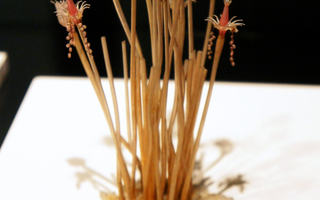In 1853, Englishman Philip Henry Gosse published “A Naturalist’s Rambles on the Devonshire Coast,” a book about marine life illustrated with gorgeous, vivid lithographs. A year later, in its sequel, he introduced the public to the concept of “The Aquarium,” with prints that were even more lush and spectacular. Well in the throes of a passion for natural history, the Victorian public went wild. As historian Lynn Barber wrote, a few years after the publication of Gosse’s books, “it was impossible to visit the seaside without tripping over parties of earnest ladies and gentlemen, armed with a book by Mr. Gosse and a collection of jamjars, standing knee-deep in rock-pools and prodding at sea-anemones.”
Prior to Gosse, the natural history of invertebrates had been a rather neglected field. To enhance their appeal, his works promoted the fun of collecting creatures that Gosse described as living jewels. A ring of jellyfish was a “coronet of sparkling diamonds”; a bivalve held up as “the pearl of the Orient”; a genus of worm hailed as “liveried in emerald and gold.” Gosse’s glittering marketing succeeded, but perhaps too greatly. The British coasts, ravaged by armies of greedy hoarders, sustained severe ecological damage, a fact that would cause the environmentally-minded author deep regret.
Jewels demand storage commensurate with their splendor. Years before, a wave of inexpensive plate glass had flooded the English market. Long accomplished through laborious and tedious grinding, the polishing of plate glass sped up with the introduction of steam power in the late 18th century. The new technology anticipated an era of cheap and widespread availability, but the heavy taxes that funded British wars had stifled the product’s diffusion. In 1845, however, Parliament decided to repeal the English glass tax. Record low glass prices, coupled with Gosse’s writings, gave rise to the modern aquarium. By the time Leopold Blaschka, glass-smith extraordinaire, began constructing his sea creatures, flamboyantly decorated aquaria had become de rigeur in wealthy American and European households: plate glass displays for their owners’ new gems.
The ‘period eye’ of late 19th century enthusiasts was trained to treasure invertebrates as glittering baubles, objects to be displayed and admired. Leopold Blaschka began his modelling enterprise in this cultural clime. In 1863, an English expatriate lent the glassworker a copy of “Actinologia Britannica: A History of British Sea Anemones and Corals,” written and illustrated by––of course––Philip Henry Gosse.
Along with the book, he gave Leopold the wise advice that glass sea creatures would be highly in demand. Despite their status as the day’s fashionable accessory, invertebrates were notoriously difficult to keep alive. In “The Aquarium,” Gosse himself recommended that “the vessel should be occasionally looked over … to see if there be any of the specimens dead.” Jarred in preservatives, however, the flesh lost its beauty: Colors faded, tissues shrank and bloated. Glass, like life, was fragile,... but, unlike life, could continue indefinitely without maintenance. Through the chance assistance of a Gosse aficionado, the philosophy of a man who saw invertebrates as jewels thus fell into the hands of a skilled jeweler. Joined later by his talented son, Leopold Blaschka meticulously made literal Gosse’s metaphor.
Read more in Arts
What We've Done With the Great Gray SpaceRecommended Articles
-
Agassiz Glass Flowers Are Unique University HighlightViewed annually by nearly 200,000 visitors, Harvard's world famed, collection of glass flowers is one of the University's leading public
-
Glass Flowers Show Mastery of Art, ScienceHarvard's most popular tourist attraction is not one of the hallmarks of University history--the John Harvard statue or Widener Library--but
-
Maker of Harvard Glass Flowers Is Dead In GermanyAfter supplying the University Museum with glass flowers for over fifty years, Rudolph Blaschka, world-famous German glass-artist, died Monday in
-
 The Cinderella Story of the ‘Oaten Pipe Hydroid’
The Cinderella Story of the ‘Oaten Pipe Hydroid’ -
Behind the Exhibits at the Harvard Museum of Natural HistoryThere is a side to the museum that is less visible to the public, and it is this dedicated collection staff working behind-the-scenes that ensures that the museum is constantly improving.













